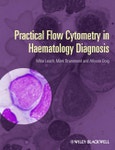The accurate diagnosis of haematologic malignancies is a complex and challenging task. It routinely involves morphologic, molecular, cytogenetic and flow cytometric expertise. To determine what treatment protocol will be followed, it is vital to integrate, interpret and report these results accurately.
Flow cytometry is key in this diagnostic pathway.
This book guides the reader as to how flow cytometry results should be interpreted and applied to optimize patient care. At the core of this text is an appreciation of clinical, morphological and immunophenotypic correlation and the importance of constant liaison and discussion between the medical and scientific teams.
The authors present a logical and practical approach to the diagnosis of blood disorders (both neoplastic and reactive) and evaluate the diagnostic applications of flow cytometry.
Practical Flow Cytometry in Haematology Diagnosis provides:
- A clinical reference source on all aspects of flow cytometry, covering both malignant and benign conditionsCarefully chosen real-life cases in each chapter, complemented by high quality morphological images
- Help in making a diagnosis, together with an understanding of the limitations of the technique and the potential pitfalls
All those who instigate, perform, interpret or act upon flow cytometry patient material will find this book an invaluable guide.
Table of Contents
Preface, vii
Acknowledgements, viii
1 Introduction, 1
References, 2
2 Principles of Flow Cytometry, 3
Introduction, 3
Sample preparation, 3
The flow cytometer, 4
The fluidic system, 4
The optical system, 5
The electronic system, 9
Data display, 9
Acknowledgements, 18
References, 19
3 Limitations, 20
Introduction, 20
Clinical context issues, 20
Sampling issues, 20
Technical issues, 25
Interpretation issues, 28
Conclusion, 29
References, 29
4 Normal Blood and Bone Marrow Populations, 31
Normal stem and precursor cell populations, 31
References, 41
5 Acute Leukaemia, 43
Introduction, 43
Identification of neoplastic precursor cells, 45
Lineage assignment of acute leukaemia, 52
Acute myeloid leukaemia, 54
Precursor lymphoid neoplasms (acute lymphoblastic leukaemia/lymphoma), 77
Examination of cerebro-spinal fluid and serous effusions, 88
Identification of genetic abnormalities by flow, 92
Conclusion, 93
References, 93
6 Chronic Lymphoid Leukaemias and Exfoliating Lymphoma, 100
Normal peripheral blood lymphoid populations, 100
Identification of clonal lymphoid populations, 101
Identification of clonal B-cell disorders, 101
CD5 positive B-cell lymphoproliferative disorders, 102
CD10 positive B-cell lymphoproliferative disorders, 116
B-cell disorders identified using an extended B-cell panel, 121
Identification of clonal T-cell disorders, 125
CD4 positive T-cell disorders, 128
CD8 positive T-cell disorders, 136
CD4/CD8 positive T-cell disorders, 141
CD4/8 negative disorders, 141
Flow cytometric assessment of serous effusions, 146
Flow cytometric assessment of cerebrospinal fluid, 146
Summary, 149
References, 149
7 Myelodysplastic Syndromes and Myeloproliferative Neoplasms, 152
Introduction, 152
Myelodysplastic syndromes, 152
Myelodysplastic/myeloproliferative neoplasms, 163
Chronic myeloid leukaemia, 165
The BCR-ABL negative myeloproliferative neoplasms, 166
Mastocytosis, 167
Summary, 170
References, 170
8 Disorders of Plasma Cells, 173
Plasma cell disorders, 173
Current diagnostic criteria, 173
Plasma cell morphology, 175
The applications of immunophenotyping to plasma cell disorders, 178
References, 183
9 Minimal Residual Disease, 184
Introduction, 184
Minimal residual disease analysis in the management of acute lymphoblastic leukaemia, 187
Conclusions, 199
Acknowledgements, 200
References, 200
10 Red Cells, Leucocytes and Platelets, 202
Paroxysmal nocturnal haemoglobinuria, 202
Red cell membrane disorders, 208
Foetal maternal haemorrhage, 211
Lymphocyte subset analysis
and immunodeficiency, 214
Haemopoietic stem cell enumeration, 214
Granulocyte disorders, 215
Platelet disorders, 219
References, 221
11 Reactive and Non-neoplastic Phenomena, 225
Peripheral blood, 225
Bone marrow, 231
Pleural and pericardial fluids, 236
Bronchoalveolar lavage specimens, 238
Cerebrospinal fluid, 238
References, 240
Index, 243








